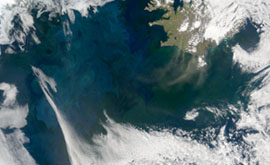
Discovery in the North Atlantic
Scientists Discover Eddies Trigger Phytoplankton Blooms in the North Atlantic
The spring phytoplankton bloom in the subpolar North Atlantic can begin up to 30 days earlier than previously thought as the result of eddies stratifying the near-surface waters, according to the results of a study reported today in the journal Science and announced by the National Science Foundation.
The discovery has implications for the Gulf of Maine, which is fed by the waters of the North Atlantic and supports similar species.
The study, part of the autonomous North Atlantic Bloom Experiment conducted in 2008, was led by Amala Mahadevan of Woods Hole Oceanographic Institution, Eric D’Asaro and Craig Lee of the University of Washington, and Mary Jane Perry of the University of Maine.
Until this latest research, scientists using climate models understood that springtime warming of the ocean surface triggered the near-surface vertical density gradation, known as stratification. That stratification, which prevents vertical mixing of the phytoplankton, and the increased seasonal light exposure that occurs every spring were thought to be the primary prompts of the bloom.
However, the research revealed that a different mechanism — eddies or small whirlpools of swirling seawater — also has the capacity to switch on the bloom and to allow the bloom to develop far earlier than the natural confluence of seasonal heat and light.
The NSF-funded study, which involved continuous observations by robots and four research cruises of up to 21 days in the waters south of Iceland, was the first to put marine scientists in the North Atlantic to actually observe the entire progression of the spring bloom over a three-month period. Their observations, which included data collected by optical, chemical and physical sensors on four autonomous underwater Seagliders, a mixed-layer water-following float and the ship, when coupled with a three-dimensional biophysical model, resulted in their discovery of a previously unknown phenomenon — eddy-driven stratification that resulted in a patchy bloom beginning 20 to 30 days earlier than it would occur through seasonal warming.
This new understanding of an underlying physical mechanism of the spring bloom will inform modeling by marine and climate scientists.
The spring phytoplankton bloom in the North Atlantic is one of the major life-sustaining events on the planet. Phytoplankton are microscopic plants at the base of the marine food web that fuel the ecosystem. These photosynthetic organisms also help maintain the health of the atmosphere by absorbing and sequestering carbon dioxide. The North Atlantic is especially important because it is responsible for more than 20 percent of the entire ocean’s uptake of carbon dioxide.
“We now know that events, such as the spring bloom, make the difference in terms of what will happen in carbon flux,” Perry says. “And because there is connectivity between the North Atlantic and the Gulf of Maine, with some of the northern water traveling to Maine, the North Atlantic is a harbinger of what may happen here.”
A team of 26 researchers from five countries was involved in the major North Atlantic research cruise in 2008. The researchers included physical and biological oceanographers with expertise in biology, chemistry and physics.
Undergraduate and graduate students were onboard, including six from UMaine.
“This experiment was an outstanding example of collaboration,” says Perry, a biological oceanographer based at UMaine’s Darling Marine Center. “One person would not have the expertise to do all of this. Together, we were able to pull this project off and come up with this new insight, and many others.”
To further collaboration efforts beyond the team, “big data” from the North Atlantic Bloom Experiment is now online and fully available in the Biological Chemical Oceanographic Data Management Office.
Last summer, the research of the scientists involved in the North Atlantic Bloom Experiment was the focus of a webinar series offered by the Center for Ocean Sciences Education Excellence – Ocean Systems (COSEE-OS) — one of 12 such centers funded by the National Science Foundation. COSEE-OS, directed by Annette deCharon at UMaine’s Darling Marine Center, focuses on improving science literacy in the context of the ocean.
The five weekly North Atlantic Bloom webinars, featuring Perry and six other scientists involved in the research, attracted 68 participants from 21 states, as well as from Canada, Iceland and Germany. More than half of the participants were educators.
The archived materials from the webinars — transcribed webinar video, data sets, and interactive concept maps with images, animations and teaching resources on the spring phytoplankton bloom and its role in the ocean ecosystem — has become the second most visited section of the COSEE-OS website.
NSF’s news release about the discovery is online.
Contact: Margaret Nagle, (207) 581-3745
